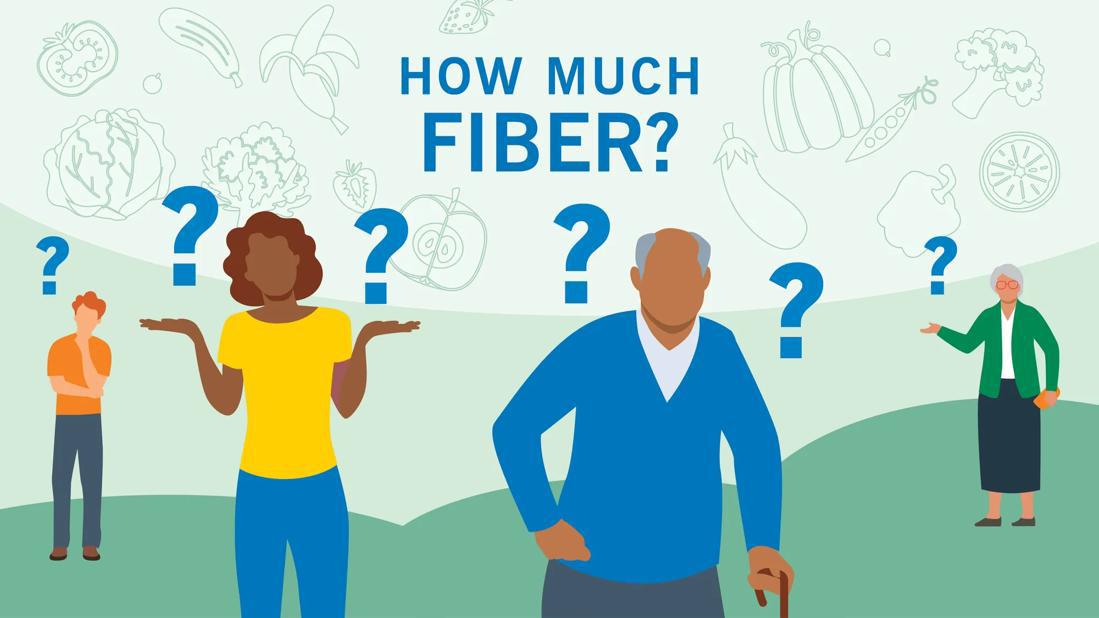Your Fiber Intake: What’s the Right Amount?
Most adults aren’t getting enough of the essential nutrient

Fiber reigns supreme when it comes to keeping your gut and heart happy. It also helps you feel full longer. This small nutrient has a big impact on your health. But how much fiber per day should you be getting?
Recommended daily fiber intake
The U.S. Department of Agriculture and U.S. Department of Health and Human Services Dietary Guidelines for Americans, 2020-2025, breaks down its dietary fiber recommendations by sex. This includes a combination of both soluble and insoluble fiber.
| Age | Women | Men |
|---|---|---|
| 19-30 | 28 grams | 34 grams |
| 31-50 | 25 grams | 31 grams |
| 51 and older | 22 grams | 28 grams |
| Age | ||
| 19-30 | ||
| Women | ||
| 28 grams | ||
| Men | ||
| 34 grams | ||
| 31-50 | ||
| Women | ||
| 25 grams | ||
| Men | ||
| 31 grams | ||
| 51 and older | ||
| Women | ||
| 22 grams | ||
| Men | ||
| 28 grams |
While these guidelines provide some direction on how much fiber per day for a woman or a man, other factors can affect your daily fiber needs, too.
“Unfortunately, these official recommendations don’t account for bodily differences like weight, height and overall health,” notes registered dietitian Beth Czerwony, RD, LD. “If you’re not sure how much fiber daily you need, ask your healthcare provider for individualized guidance.”
Are people getting enough fiber?
You probably need more fiber than you’re currently getting. Studies show that only about 5% of U.S. adults get enough fiber in their diets, with most people consuming only about 16 grams (g) per day.
How to increase fiber intake
Czerwony shares some advice on the best ways to get more fiber.
Choose foods that are high in fiber
It’s always best to try to get your vitamins, minerals and other nutrients through your diet — and fiber is no different.
“It’s important to get fiber sources from a variety of fruits, vegetables, whole grains, beans and legumes in order to have a healthy and balanced diet,” Czerwony says.
Try these four food groups that are high in fiber:
- Legumes: Beans, lentils, lima beans, dried peas, etc.
- Whole grains: Whole-wheat products, bran, steel-cut or rolled oats, barley, quinoa, brown rice, rye, corn, etc.
- Fruits: Apples, berries, oranges, pears, plums, bananas, etc.
Incorporate fiber into every meal
There are countless ways to add fiber into your diet. Here are a few tips to consider throughout the day:
- Breakfast. Switch to steel-cut oatmeal, rolled oats or whole-wheat cereal with at least 5g of fiber, and top it with fruit like raspberries and blackberries.
- Lunch. Pair lentil stew or bean soup with a sandwich made on hearty whole-wheat bread.
- Dinner. Serve a healthy helping of salad or vegetables with a whole-grain side like brown rice, whole-wheat pasta, bulgur or quinoa.
“You can also sprinkle bran, ground flaxseed or chia seed into soups, cereals, spaghetti sauce, casseroles or yogurt,” Czerwony suggests. “They add a big hit of fiber without changing much in the way of taste.”
Slowly add fiber
A key piece of advice when it comes to upping how much fiber you eat? Go slow, says Czerwony. Adding too much fiber all at once can cause bloating and cramping.
“To avoid bloating and gas, add in no more than 5 grams of fiber per week until you reach your individual goal,” she recommends.
Drink plenty of water
Water is vital for many reasons, but when it comes to fiber, it’s essential to keep your bowel movements regular. If you’re adding fiber, make sure you drink plenty of water. If not, it can lead to constipation.
Should I take a fiber supplement?
If you’re having a hard time getting enough fiber from the foods you eat, your healthcare provider may recommend a supplement.
“Food is your best source of fiber, but supplements can help if you’re not able to get adequate amounts through diet,” Czerwony reiterates.
Just be sure to speak with a healthcare professional before taking any supplement, fiber included.
Bottom line?
“How much fiber do I need a day?” It’s one of the most common questions Czerwony and other dietitians hear. And while dietary fiber guidelines can give you a good starting point, in many cases, you’ll need to increase your fiber intake.
Remember, “Fiber is crucial for overall health by aiding in blood sugar management, its positive impact on digestion and heart health,” says Czerwony.